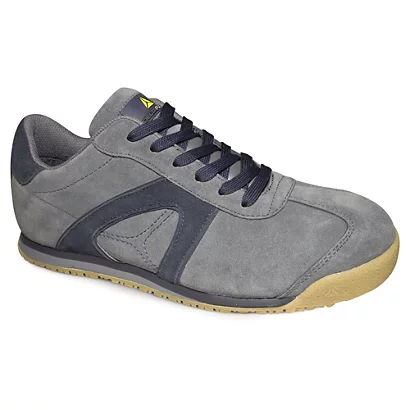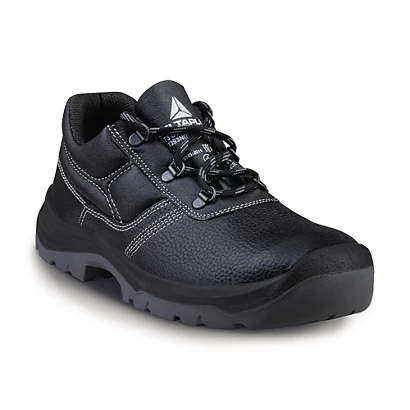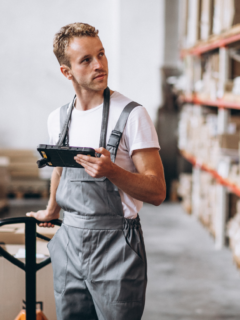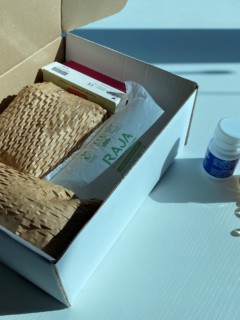In the workplace safety arena, safety shoes are a crucial element in protecting workers. Whether in industrial environments, construction sites or laboratories, choosing the right type of footwear is crucial to ensure safety and comfort.
In the workplace, but also at home, in sport and play, all those products necessary for the protection of the individual that are used for their own safety and health are called PPE (personal protective equipment).
In this article we will talk in detail about safety shoesthat is, all footwear that is indispensable and obligatory for carrying out certain tasks, we will explore the different types, their characteristics, resistance and levels of protection.
What are safety shoes?
In various daily activities, whether professional or leisure, the risk of injury is just around the corner: injuries, bruises, burns and more. A fundamental element for individual safety, especially in certain work contexts, are safety shoes. These shoes, which as already mentioned fall under the category of PPE, are designed with the aim of safeguarding the feet from multiple hazards that may be encountered while performing certain tasks. For example, they can offer protection against electrostatic discharges, the risk of being crushed by heavy objects, or prevent injuries due to sharp elements such as nails protruding from wooden boards, pallets or work surfaces.
Safety shoes are not just an accessory, but an essential component of safety equipment in many work areas. Designed with advanced features, these shoes often include reinforcements such as steel or Kevlar toe caps and reinforced soles to resist punctures. The materials used are selected for their resistance properties, such as water repellency, which is essential to avoid contact with harmful liquids. The choice of safety shoes varies according to the specific risks associated with each work environment, thus ensuring the appropriate protection in each situation. Legislation, such as Legislative Decree 81/2008, emphasises the obligatory nature of this footwear in many work contexts, highlighting the importance of this precautionary measure for safety at work.
How to choose safety shoes
Let’s better understand how to choose safety shoes and identify the model that best suits your needs. It is clear that each profession presents unique challenges , and the choice of protective equipment and tools must be purposeful and informed. For example, those working on a construction site need footwear that prevents damage from falling heavy objects such as bricks or punctures from debris, while electricians and plumbers, who often work on their knees, might favour lightweight, flexible and, for the latter, even waterproof shoes to keep their feet dry in the event of a water spill.
In order to be considered compliant and obtain CE certification, safety shoes must fulfil specific criteria established by the European Directive EEC 89/686. The appropriate choice is made by understanding the classifications, which begin with the letter ‘S’ (Safety), symbolising the safety properties of the footwear, followed by other letters or numbers that define its detailed characteristics.
Classification of safety footwear
To best choose the right safety shoes for you, you will need to know how they are classified. Legislation marks them with the letter ‘S’, Safety, followed by further letters or numbers that indicate the specific characteristics and type of protection.
Let’s look at this classification together:
- SB (Basic Safety): corresponds to the essential standard EN 20345, with a protective toecap for impacts up to 200 joules and an oil-resistant sole.
Class 1
These shoes are made by combining leather and other materials, excluding models made entirely of rubber or polymer.
- S1: in addition to SB standards, includes antistatic resistance, anti-shock heel protection and a hydrocarbon-resistant sole, ideal for dry locations. Low work shoes in suede mesh belong to this category .
- S2: in addition to S1, features a water-repellent upper that resists water, suitable for very wet environments.
- S3: complements the specifications of S2 with an outsole suitable for wet environments and uneven terrain thanks to a puncture-resistant, lugged outsole. An example? The pigmented leather low work shoes
- S3L / S3S: same as S2 with the addition of a studded and anti-puncture sole with non-metallic insert
- S6: has all the characteristics of S2 with the addition of water resistance
- S7L / S7S: an even higher performance version of S3L, water resistant
Class 2
These are models formed exclusively from rubber, using the vulcanisation process, or from polymer, using the moulding technique.
- S4: guarantees all the basic qualities and includes antistatic properties and energy absorption at the heel, often associated with boots for very wet environments.
- S5L / S5S: an even higher performance version of S4 with anti-puncture sole and midsole
- S5: represents the highest level of protection, combining the features of S4 with an anti-puncture midsole and lug sole.
Hybrid Footwear
They are characterised by having the upper part of the upper made of rubber (fully vulcanised) or polymer (fully moulded), while the upper part is made of leather or other materials. SBHsbelong to this category .
Caracteristics of safety shoes
Let us now take a look at the main characteristics of safety shoes:
- Low and high safety shoes:
- Low shoes are ideal for environments where mobility is key, offering comfort and agility.
- High shoes, on the other hand, provide greater protection to the ankle, being ideal for uneven terrain or work requiring additional stability.
- Heavy and light work shoes:
- Heavy versions are designed to offer maximum protection in high-risk environments, such as construction sites and heavy industries.
- Lightweight shoes are suitable for indoor environments or work requiring long hours on your feet, combining protection and comfort.
- Summer and winter versions:
- Summer shoes feature breathable materials that allow good ventilation, keeping feet dry and cool.
- Winter versions are insulated and waterproof, protecting the feet from the cold and wet.

Resistance and Safety
Safety shoes are classified according to specific standards that define the levels of protection they offer. The main features include:
- Steel or composite toe cap: protects toes from falling heavy objects.
- Anti-puncture sole: prevents penetration by sharp objects.
- Slip resistance: provides stability on slippery surfaces.
- Anti-static properties: dissipates electrostatic charges to prevent electric shocks.
- Resistance to oils, acids and chemicals: protects feet from hazardous substances.
Who uses safety shoes?
To further assist you in choosing the right safety shoes for your working needs, we have compiled some examples illustrating typical applications for each safety class mentioned. These examples will guide you in your choice, making it easier to understand the different acronyms and their practical applications:
- Up to S1/S1P: these classes are ideal for people working in environments such as DIY shops, small carpentries or doing light renovation work. If the work involves the risk of encountering sharp objects that could pierce the sole, class S1P is recommended for its anti-puncture sole.
- S2: this category is perfect for those working in wet environments or where there is frequent contact with water, such as in the food and fish sectors, in large kitchens or in hospital settings. Thanks to their water-repellent upper, S2 shoes offer reliable protection against moisture.
- S3: S3-rated shoes are suitable for a wide variety of workers, combining the characteristics of S1P and S2. They are the ideal option for those employed in industries, machine shops, warehouses or agriculture, as they provide comprehensive protection against different types of hazards.
- S4 and S5: These categories represent the evolution of the previous classes, offering total protection. S4s are recommended when unlimited waterproofing is required, while S5s add puncture protection, making them suitable for extremely demanding environments where foot protection is crucial.
It is important to note that as one goes up in category, the safety features increase and, consequently, so does the price. This increase reflects the greater complexity of construction and the use of advanced and durable materials, which are indispensable for offering maximum protection in every working situation.
The materials of safety shoes
The choice of safety shoes goes far beyond the aesthetic or fashion aspects that normally influence the purchase of conventional footwear. Safety at work imposes selection criteria based primarily on the quality and properties of the materials used, which are essential to ensure maximum protection and comfort during working hours.
- Uppers: the upper part of the shoes, the uppers, are often made of various types of leather such as smooth leather, suede, mesh or nubuck, depending on durability and resistance requirements. Synthetic materials or special fabrics may be chosen to improve features such as breathability or waterproofing, and in some cases, fire resistance.
- Toe caps: the basic protective elements of safety shoes, the toe caps, can be made of steel, aluminium or Kevlar. The choice of material varies according to the balance between lightness and protection. Kevlar is preferred for its flexibility or in contexts where the use of metal is limited, such as airports.
- Insoles: shoes include removable insoles that provide cushioning and arch support. They are made of materials such as foam or non-woven fabric, placed over a fixed insole, which connects the upper to the sole, ensuring breathability and comfort.
- Soles: materials such as polyurethane, thermoplastic polyurethane or nitrile rubber are chosen for the manufacture of soles, depending on specific requirements such as resistance to acids, hydrocarbons, heat, or antistatic properties, crucial in certain work environments.
- Anti-perforation sheet: located in the sole, this sheet prevents perforations. Although traditionally made of steel, Kevlar is an alternative when greater flexibility is required or in situations where metallic materials are not recommended.
Other details, such as elastic laces or padding on the collar and tongue, are designed to improve the comfort and adaptability of the shoes, which are no less important when it comes to wearing them for long periods. All these elements combine to create a shoe that not only protects the user from the hazards specific to his or her working environment, but also provides the support and comfort needed to get through the working day.
Which colours to choose for safety shoes?
The choice of colour for safety shoes should be guided by functionality and the working environment rather than by fashion. For example, colours such as beige or brown are preferable in construction sites or dusty places, as they make dirt less visible. In machine shops or environments where oil and grease are prevalent, dark colours such as grey or black are ideal. Coloured or reflective inserts can add an aesthetic touch and improve visibility at night for those working in dimly lit areas or at night.
When to change safety footwear
All personal protective equipment (PPE), shoes, must be maintained in optimal condition to ensure their protective effectiveness.
Safety shoes, when used correctly and for the specific purposes for which they were designed, generally have an average lifespan of about one year, although this period may vary depending on intensity of use and care in maintenance.
It is necessary to replace safety footwear when one of the following conditions occurs:
- Damage such as breaks or deformations in the toes, insoles or any other element of the shoes
- The presence of cracks, cuts or any modification that alters the structural integrity of the footwear
How to wash safety shoes
To ensure the longevity and effectiveness of personal protective equipment, it is crucial to emphasise the importance of thorough maintenance. Good cleaning ensures that safety shoes retain their functionality, such as optimal grip on the ground, which can be compromised by mud or debris accumulated during use. In addition, removing residues of corrosive substances after use preserves the integrity of the materials. It is essential to keep reflective elements clean, especially for those working in low light conditions or at night, so as not to compromise visibility and safety.
The cleaning of shoes varies depending on the material: those made of smooth leather or synthetic materials can be easily cleaned with a damp cloth, while stubborn stains can be treated with white vinegar. For leather shoes, water stains can be removed with cotton soaked in cleansing milk. For materials such as nubuck or suede, cleaning requires a soft bristle brush, and for persistent stains, vinegar or an eraser can be used, followed by a final brushing.
Please always check the manufacturer’s user and maintenance booklet for the average life of the shoe and washing instructions.
Some safety shoes are machine washable, but it is essential to follow the manufacturer’s instructions, limiting the temperature to 40 degrees. When drying, it is preferable to expose them to the open air, avoiding the use of dryers or direct heat sources that could damage crucial components such as the sole.
In conclusion, the safety shoes are not only a regulatory requirement for many professions, but a fundamental ally for personal safety. Choosing the right pair of shoes not only safeguards your physical integrity against everyday hazards in the workplace, but also contributes to your comfort and productivity. In a wide and varied market, the importance of an informed and conscious selection is more essential than ever. From water repellency to thermal resistance, from puncture protection to flexibility, every detail of safety footwear is designed to meet specific needs. That’s why, thanks to the information provided in this article and with a thorough knowledge of current regulations, you are now in a position to make an informed choice of the most suitable safety footwear for you and your work.
For any further advice or clarification on the best products for your specific needs, please do not hesitate to contact our experts. Your safety is our priority, and we are here to support you every step of the way to a safer and more comfortable working environment.















